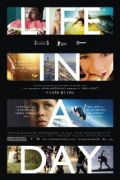
Directed by
Kevin McDonald
90 minutes
Rated PG
Reviewed by
Sharon Hurst

Life In A Day
Synopsis: YouTube invited people worldwide to upload video submissions featuring scenes from their daily lives. 80,000 people from 192 countries submitted 4,500 hours of footage. The end result is a film chronicling one day of life around the globe on 24 July 2010.
Wow, this film is really something – social internet experiment becomes feature film, and one that for me is both an absolute eye-opener and fabulously entertaining. To edit disparate footage from so many people into what becomes a consolidated and coherent film is in my book a major achievement. McDonald certainly knows what he is doing, and with Ridley and Tony Scott’s production company backing him, he had the resources to do it.
Those who are not people watchers may get bored with 90 minutes of imagery and minimal spoken word. But this is about the fundamentals of everyone’s life, irrespective of linguistic differences, from the daily minutiae through to deeper and more profound themes. These are the things that unite us as human beings and make for a commonality of human experience, regardless of race, religion, politics or place of birth. Thus we have activities as basic as waking up, making breakfast, cleaning teeth, visiting the toilet, through to more profound things like a family thrown into chaos by a cancer diagnosis, or a girl saying she does not want to cease to exist but wants her life recognised. While we see similarities we also see differences. We see babies, death, riots, fires, wedding proposals, a lad telling his mum he’s gay, shoplifting, soldiers at war - almost anything you can think of gets a guernsey, even if fleeting, in this film (no sex though – a regrettable omission perhaps).
There is a very loose structure built around the questions that have been asked of the participants, including possibly the most universal, “What do you love?” and “What do you fear?” The answers are as varied as the respondents, and also an invitation for us to ask ourselves the same. Whether poverty-stricken in a Namibian village or wealthy Westerners, we generally all love our families and we generally all fear oblivion. And despite scenes of negative things in the world (people being crushed at a German street festival), overall people come across as happy and content with their daily lives (or is this just what the film-makers chose to portray?). One man, a Korean bicycling around the world for the past seven years, recurs several times, as a loose link and further testament to the idea of the global village.
Life In A Day follows a consecutive time frame, from about 3 am through to bedtime the following evening. Perhaps there will be accusations of a certain slickness and contrivance to the film, and inevitable comparisons to Godfrey Reggio’s classic Koyaanisqatsi (1982) but there is something very exciting about a film whose elements come from us, the hoi polloi, not from the minds of screenwriters.

Want more about this film?


Want something different?




